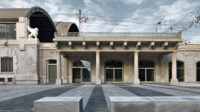BAM's Next Wave: A Forward-Looking Institution Updates Its Own Look with a Nod to the Past

BAM's Next Wave: A Forward-Looking Institution Updates Its Own Look with a Nod to the Past
The 132-foot-long canopy spans the facade's five entry bays.
Photo © Peter Mauss/Esto

BAM's Next Wave: A Forward-Looking Institution Updates Its Own Look with a Nod to the Past
Glass panels are aligned head-to-toe. In between, joints are closed with silicone to keep water out.
Photo © Peter Mauss/Esto

BAM's Next Wave: A Forward-Looking Institution Updates Its Own Look with a Nod to the Past
Steel columns were added to the existing steel frame to support the canopy.

BAM's Next Wave: A Forward-Looking Institution Updates Its Own Look with a Nod to the Past
The rotules were designed to have rotating capability.




